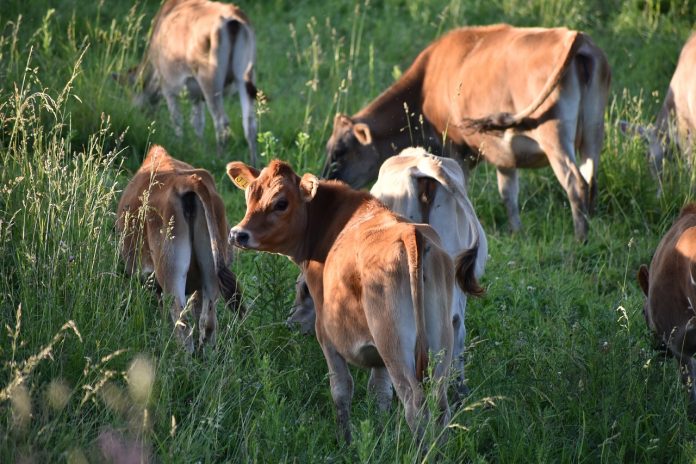Internal parasites plague many different species of livestock. Here are six tips to keep parasites under control.
1Grazing management
Pasture rotation is one way to help prevent overgrazing, which increases the risk of parasites. Internal parasite eggs are passed in livestock manure and reach an infective stage as quickly as six days later.
If fields are subdivided with temporary fencing and animals rotate into a new area every six days, the animals are out of the old field by the time the parasites reach an infective stage.
Larvae can survive up to 120 days in cool, moist conditions but die much more quickly in hot, dry weather.
Fields can be harvested for hay so that larvae are exposed to and killed by heat and sunlight, or caretakers can plan long rest periods for a field so parasites die before the animals return to that field.
2Multi-species grazing
Not all species share the same parasites. For example, sheep and goats share parasites, but these same parasites cannot survive in cattle and horses.
Graze cattle and horses on the same pasture as sheep and goats, either at the same time or in a leader-follower system, to break the parasite life cycle.
3Sanitization
Keep any stall areas clean to reduce the risk of parasite infestation. Manure should be moved to compost piles or spread on pastures and croplands that are not used for grazing.
4Use feed containers
Feed animals out of containers, like haymangers and feed bunks, instead of on the ground to reduce the risk of parasite infestation. Feeders and water buckets and troughs should be cleaned out regularly to prevent fecal contamination.
5Group animals
Group animals based on how susceptible they are to parasites so they can be treated appropriately. For example, young animals are often more susceptible than adult animals and should be kept on safer pastures.
Animals that have repeatedly had issues with parasites should also be kept on safer pastures, and should ideally be culled or not bred in favor of less susceptible animals.
Animals should not be overstocked in any pastures. Heavily stocked pastures create a higher infestation risk than lightly stocked pastures.
6Deworm
Different animals have different deworming needs. Conducting or having a veterinarian conduct fecal examinations to get a worm egg count is a good way to determine which animals need to be treated. Egg counts before and after deworming can also help determine the effectiveness of a particular dewormer.
Watch for signs of abnormal behavior and appearance and regularly check anemia levels in the mucous membranes of the eyelids, gums or vulva of the animal. If an animal’s mucous membranes are red or red-pink, they are not anemic, but if they are pink, pink-white or white, they are anemic and should be treated for parasites.
Sources: Goat diagnostic methods, extension.org; Dairy goat management, extension.org; Prevent parasites through grazing management, Penn State Extension; Internal parasites in beef and dairy cattle, extension.org; Management and control of internal parasites in horses, extension.org.
(Farm and Dairy is featuring a series of “101” columns throughout the year to help young and beginning farmers master farm living. From finances to management to machinery repair and animal care, farmers do it all.)
More Farming 101 columns:
- 6 tips for vaccinating your livestock
- 5 tips to prevent dairy cow foot problems
- 6 common foot problems found in dairy cows
- Recognize, prevent heat stress in dairy cattle
- How to monitor your dairy herd
- How to start your own dairy farm
- 5 tips for sun safety in the field
- Employing youth for the summer
- What to do if a hay fire occurs
- How to prevent hay fires
- How to extend the life of your fence
- 10 safety tips for installing electric fences
- How to chose the right fence for your farm
- How to create a fencing plan
- 7 steps for easy sprayer calibration
- Prepare for planting season, Part 2: Calibration
- Prepare for planting season, Part 1: The Basics
- 7 tips to improve security on your farm
- 5 tips to protect your farmland
- 3 measures to deal with severe farm debt
- How to buy time to catch up on farm debt
- 6 tips to manage income on the farm
- 5 tips to recognize and deal with farm stress
- How to prepare a livestock birthing kit
- 5 tips for marketing your farm
- How to develop farm mission, vision statements
- 5 tips for setting farm goals
- 2 types of livestock insurance policies
- 6 things you need to know about WFRP plans
- 3 basics of crop insurance
- How does liability insurance work on the farm?
- Why do I need farm insurance?
- How to understand and use Ohio’s CAUV
- How to utilize the Pa. Clean and Green Act
- 9 tips for filing farm taxes
- 8 reasons record keeping for taxes is essential
- 5 tips for post-harvest storage
- 7 tips for family meetings on the farm
- 4 tips for balancing your farm and family
- 4 tips for communicating on the family farm
- 4 tips for firing an employee
- 6 tips for keeping good farm help
- 4 tips for recruiting farm labor
- 5 general farm labor laws
- 4 tips for employing minors
- 4 tips for PTO safety
- 5 things young farmers should know about finances
- The farm balance sheet
- 5 items for your farm’s cash flow statement
- Personal and business records: Keep them separate
- What to include in your farm business plan
- How to approach a lender: Tips for getting a farm loan
- How to use microloans to get your farm started
- Saving for the future: 6 tips for young farmers
- How to create a farm safety kit
- 5 tips for child safety on the farm
- 4 tips for transporting livestock
- 5 ways to better understand tractor stability
- 6 farm equipment hacks













Thank you, I’m looking forward to learning more from you.
You’re so wonderful
Thanks for your help guys